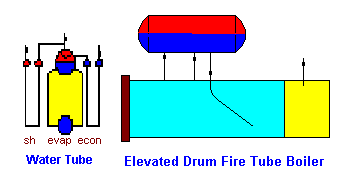
| tube size,in | 1.75x1.521 | 1.75x1.521 | 1.75x1.521 | 2.5x2.238 | 2.5x2.238 | 2.5x2.238 |
| velocity,fps | 98 | 123 | 163 | 98 | 123 | 162 |
| tubes | 1000 | 800 | 600 | 470 | 375 | 280 |
| length,ft | 15.75 | 16.75 | 18 | 24.75 | 26.0 | 28.5 |
| surface,ft2 | 6269 | 5333 | 4298 | 6812 | 6710 | 4673 |
| Ui | 9.47 | 11.08 | 13.70 | 8.73 | 10.29 | 12.72 |
| DPg,in wc | 2.05 | 3.34 | 6.23 | 1.95 | 3.16 | 6.00 |
| item | boiler 1 | boiler 2 |
| furnace widthxheightxlength | 6x10x22 | 6x10x29 |
| furnace proj area (duty) | 802(36.6) | 1026(40.4) |
| volumetric HRR(Btu/ft3h) | 90,500 | 68,700 |
| area HRR(Btu/ft2h) | 149,000 | 116,600 |
| furnace exit gas temp,F | 2364 | 2255 |
| boiler exit gas temp,F | 680 | 610 |
| economizer exit gas temp,F | 315 | 315 |
| evaporator surface(duty) | 3972(53.7) | 4760(52.1) |
| economizer surface(duty) | 8384(10.5) | 8550(8.3) |
| geometry | evap/econ | evap/econ |
| tubes/row | 11/15 | 10/15 |
| number deep | 66/14 | 87/10 |
| length,ft | 9.5/11 | 9.5/10 |
| economizer fins | 3x.75x.05x.157 | 5x.75x.05x.157 |
| transverse pitch,in | 4/4 | 4.375/4 |
| Example: A gas turbine HRSG generates 200 psig saturated steam from feed water at 230 F.An Economizer is not used.The gas flow=150,000 lb/h at 1000 F. Exit gas temperature=423 F.Duty=22.74 MM Btu/h. gas pressure drop= 2 in wc. Steam flow=22,600 lb/h. For these SAME parameters,let us design 2 evaporators with different fin configurations as shown below and compare the surface areas.Tube size=2x.105 in ,fouling factors=0.001 on both sides. |
| item | option 1 | option 2 |
| tubes/row | 30 | 27 |
| no of rows deep | 14 | 24 |
| effective length,ft | 7 | 7 |
| fins | 4.5x.875x.05 | 2x.625x.05 |
| transverse pitch | 4 | 3.875 |
| overall U | 6.46 | 11.04 |
| surface areas,ft2 | 17,523 | 10,204 |